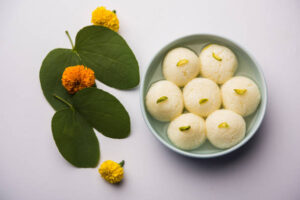
How to Make Rasgulla at Home – Soft, Spongy & Delicious!
Rasgulla (रसगुल्ला), a famous Bengali dessert, is one of the most loved sweets in India. Soft, spongy, and juicy white balls dipped in sugar syrup – this sweet treat melts in your mouth and leaves a lasting taste. In this article, you’ll learn how to make rasgulla at home with simple ingredients and step-by-step instructions. Plus, scroll down to see the beautiful rasgulla pic that will make your mouth water!
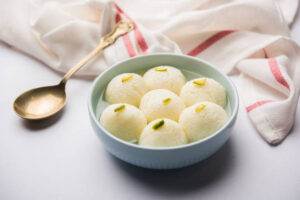
What is Rasgulla (रसगुल्ला)?
Rasgulla, also known as रसगुल्ला in Hindi, is a soft, spongy, syrup-soaked dessert made primarily from chhena (fresh Indian cottage cheese) and semolina, kneaded into smooth balls and cooked in a lightly flavored sugar syrup. It is one of India’s most iconic sweets, especially popular in Eastern India.
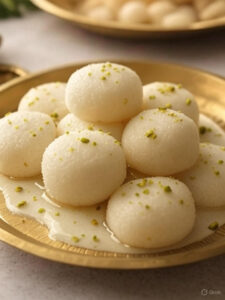
When and Where Was Rasgulla First Made?
The origins of Rasgulla are the subject of a long-standing and passionate debate between the Indian states of Odisha and West Bengal:
- Odisha’s Claim: Historical records and temple offerings suggest that a version of rasgulla called Khira Mohana has been served at the Jagannath Temple in Puri for over 700 years, especially during the “Niladri Bije” ritual. Odisha argues that rasgulla originated as a temple sweet and later evolved.
- West Bengal’s Claim: In Bengal, rasgulla as we know it today was popularized in the 19th century by Nobin Chandra Das, a Bengali confectioner from Kolkata. Around 1868, he is credited with inventing a spongier and more refined version of the sweet by boiling chhena balls in sugar syrup — a technique that preserved the softness and shelf life.
In 2017, West Bengal received the Geographical Indication (GI) tag for “Banglar Rasogolla,” while Odisha was granted a GI tag for its own version called “Odisha Rasagola” in 2019 — highlighting that both regions have unique claims and recipes.
Why is Rasgulla So Popular?
Rasgulla’s popularity can be attributed to several factors:
- Delicate Taste and Texture: Its light, spongy texture and mildly sweet flavor make it refreshing and not overwhelmingly rich, unlike many other Indian desserts.
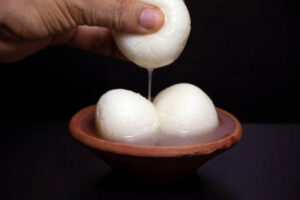
- Cultural Significance: Rasgulla plays a key role in religious rituals and festivals, especially in Eastern India. It symbolizes purity and celebration.
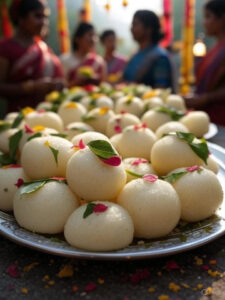
- Widespread Availability: Over the decades, rasgulla has traveled beyond its place of origin and is now made, sold, and enjoyed across all parts of India and even globally.
- Innovation and Variety: From canned rasgullas to flavored or stuffed versions (like chocolate or saffron), its adaptability has kept it relevant in modern culinary trends.
Ingredients to Make Rasgulla (रसगुल्ला)
To learn how to make rasgulla, you’ll need a few simple ingredients that are commonly found in most Indian kitchens. Here’s what you’ll need for a basic batch:

Main Ingredients:
- 1 litre full-fat milk
→ This is used to make chhena (fresh Indian cottage cheese), the base ingredient for rasgulla. Use cow’s milk or full-cream milk for best results, as it yields soft and spongy chhena. - 2 tablespoons lemon juice or white vinegar
→ Used to curdle the milk and separate the chhena from the whey. You can dilute it with 2 tablespoons of water to avoid a sour taste.
For the Sugar Syrup:
- 1 cup sugar
→ This sweetens the syrup in which the rasgullas are cooked and soaked. - 4 cups water
→ The sugar needs to dissolve and boil in water to create a light syrup, ideal for absorbing flavor into the rasgullas.
Optional Flavors:
- 1 teaspoon rose water or ½ teaspoon cardamom powder
→ These are optional but recommended for enhancing aroma and flavor. Rose water adds a floral touch, while cardamom adds warmth and a traditional Indian essence.
How Many Rasgullas Can You Make With This Recipe?

From 1 litre of full-fat milk, you can typically prepare 10 to 12 medium-sized rasgullas. The number may vary slightly depending on:
- How well the chhena is drained and kneaded
- The size of each rasgulla ball
- How much whey is retained or lost during curdling
If you prefer smaller rasgullas, you can easily make 12 to 15 pieces, but for soft, spongy results, avoid making them too large, as they expand when boiled in syrup.
How to Make Rasgulla (रसगुल्ला) – Step-by-Step Recipe
Making soft, spongy rasgullas at home may seem tricky, but by following these clear steps and tips, you’ll get perfect results every time!
Step 1: Prepare Chhena (Paneer)
- Boil the Milk:
- Pour 1 litre of full-fat milk into a heavy-bottomed pan.
- Heat on medium flame and stir occasionally to prevent burning at the bottom.
- Once the milk comes to a rolling boil (around 90–95°C or 194–203°F), turn off the flame immediately.
- Curdle the Milk:
- Slowly add 2 tablespoons of lemon juice or vinegar, diluted with 2 tbsp water.
- Stir gently and continuously. The milk will begin to curdle, and the whey (a greenish liquid) will separate from the solids.
- Strain the Chhena:
- Pour the curdled milk through a muslin or cheesecloth placed over a strainer.
- Rinse the chhena under cold running water to remove the acidic flavor of the lemon/vinegar.
- Remove Excess Water:
- Gather the cloth and squeeze out as much water as possible.
- Hang the cloth for 30–40 minutes to allow the chhena to lose excess moisture.
- It should be moist but not watery — just soft enough to knead.
Step 2: Knead the Chhena
- Smooth the Dough:
- Place the drained chhena on a clean plate or surface.
- Using the palm of your hand, knead it for 8–10 minutes until the texture becomes smooth, soft, and slightly greasy.
- This step is crucial — under-kneading results in grainy rasgullas, while over-kneading can make them hard.
- Shape into Balls:
- Divide the kneaded dough into 10–12 equal portions.
- Roll each portion into a smooth, crack-free ball. Cracks may cause the rasgulla to break while boiling.
Step 3: Prepare the Sugar Syrup
- Make the Syrup:
- In a wide and deep pan, add 1 cup sugar and 4 cups water.
- Heat the mixture over medium flame, stirring until the sugar dissolves completely.
- Bring it to a gentle boil (about 100°C or 212°F).
- Add Rasgulla Balls:
- Once the syrup is boiling gently, drop the rasgulla balls carefully, one by one.
- Ensure the pan is large enough for the balls to expand while cooking.
- Boil and Cook:
- Cover the pan with a lid and cook on medium flame for 12–15 minutes.
- Maintain a steady boil throughout. The rasgullas will puff up and nearly double in size.
- Tip: You can open the lid once or twice to gently stir the syrup (without disturbing the rasgullas), ensuring even cooking.
Step 4: Cool and Flavor
- Rest in Syrup:
- Once cooked, turn off the flame and let the rasgullas rest in the syrup for 30–45 minutes.
- This helps them absorb more syrup and become juicy.
- Add Flavoring:
- Add 1 teaspoon rose water or ½ teaspoon cardamom powder to the syrup for a delightful aroma.
- Chill and Serve:
- Transfer the rasgullas to a bowl along with some syrup.
- Refrigerate for 1–2 hours before serving — chilled rasgullas are softer and more refreshing.
Rasgulla Pic – Mouthwatering Softness!
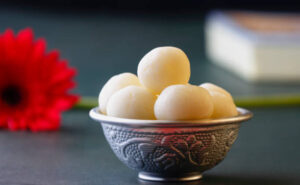
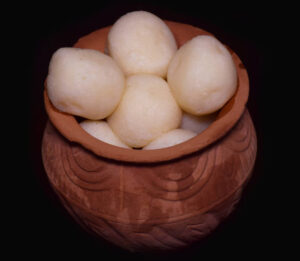
Soft, spongy रसगुल्ला ready to serve!
Pro Tips for Perfect Rasgulla (रसगुल्ला)
- Always use full-fat milk for best chhena texture.
- Kneading the chhena is key – don’t skip this step.
- Do not overcook the rasgullas or they may become rubbery.
- Keep enough space between the rasgullas in the pan so they can expand without sticking.
- Make sure the sugar syrup stays boiling while cooking rasgullas.
FAQs About Rasgulla
❓ How long does rasgulla last?
You can store rasgullas in the refrigerator for up to 5 days.
❓ Can I use citric acid instead of lemon juice?
Yes, you can use a pinch of citric acid dissolved in water.
❓ Why do rasgullas become hard?
Not kneading the chhena properly or overcooking can make them hard.
Conclusion
Now that you know how to make rasgulla, it’s time to bring sweetness to your kitchen! This easy recipe for soft, juicy रसगुल्ला is sure to win everyone’s hearts.
